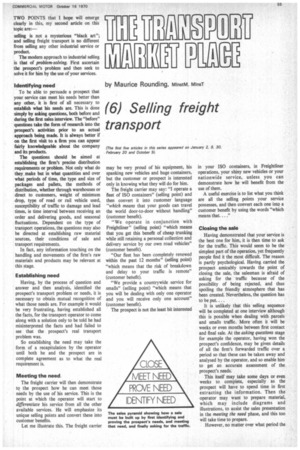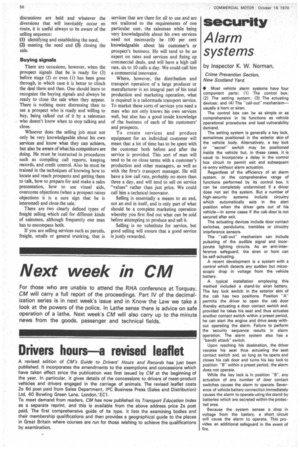by Maurice Rounding, minstm, mins - r
Page 57

Page 58

If you've noticed an error in this article please click here to report it so we can fix it.
(6) Selling freight transport
TWO POINTS that I hope will emerge clearly in this, my second article on this topic are:—
selling is not a mysterious "black art"; and selling freight transport is no different from selling any other industrial service or product.
The modern approach to industrial selling is that of problem-solving. First ascertain the prospect's problem and then seek to solve it for him by the use of your services.
Identifying need To be able to persuade a prospect that your service can meet his needs better than any other, it is first of all necessary to establish what his needs are. This is done simply by asking questions, both before and during the first sales interview. The "before" questions take the form of research into the prospect's activities prior to an actual approach being made. It is always better if on the first visit to a firm you can appear fairly knowledgeable about the company and its products.
The questions should be aimed at establishing the firm's precise distribution requirements or problem. Not only what do they make but in what quantities and over what periods of time, the type and size of packages and pallets, the methods of distribution, whether through warehouses or direct to customers, weight of minimum drop, type of road or rail vehicle used, susceptibility of traffic to damage and lead times, ie time interval between receiving an order and delivering goods, and seasonal fluctuations. Dependent on the type of transport operations, the questions may also be directed at establishing raw material sources, their conditions of sale and transport requirements.
In fact, any information touching on the handling and movements of the firm's raw materials and products may he relevant at this stage.
Establishing need Having, by the process of question and answer and then analysis, identified the prospect's transport problem or needs, it is necessary to obtain mutual recognition of what those needs are. For example it would be very frustrating, having established all the facts, for the transport operator to come along with a solution only to be told he had misinterpreted the facts and had failed to see that the prospect's real transport problem was.
So establishing the need may take the form of a recapitulation by the operator until both he and the prospect arc in complete agreement as to what the real requirement is.
Meeting the need
The freight carrier will then demonstrate to the prospect how he can meet those needs by the use of his service. This is the point at which the operator will start to differentiate his service from all the other available services. He will emphasize its unique selling points and convert these into customer benefits.
Let me illustrate this. The freight carrier may be very proud of his equipment, his spanking new vehicles and huge containers, but the customer or prospect is interested only in knowing what they will do for him.
The freight carrier may say: "I operate a fleet of ISO containers" (selling point) and then convert it into customer language "which means that your goods can travel the world door-to-door without handling" (customer benefit).
"We operate in conjunction with Freightliner" (selling point) "which means that you get this benefit of cheap trunking while still retaining a personal collection and delivery service by our own road vehicles" (customer benefit).
"Our fleet has been completely renewed within the past 12 months" (selling point) "which means that the risk of breakdown and delay to your traffic is remote" (customer benefit).
"We provide a countrywide service for smalls" (selling point) "which means that you will be dealing with only one operator and you will receive only one account" (customer benefit).
The prospect is not the least bit interested in your ISO containers, in Freightliner operations. your shiny new vehicles or your nationwide service, unless you can demonstrate how he will benefit from the use of them.
A useful exercise is to list what you think are all the selling points your service possesses, and then convert each one into a customer benefit by using the words "which means that...."
Closing the sale Having demonstrated that your service is the best one for him, it is then time to ask for the traffic. This would seem to be the simplest part of the operation, yet frequently people find it the most difficult. The reason is partly psychological. Having carried the prospect amicably towards the point of closing the sale, the salesman is afraid of asking for the traffic because of the possibility of being rejected, and thus spoiling the friendly atmosphere that has been created. Nevertheless, the question has to be put....
It is unlikely that this selling sequence will be completed at one interview although this is possible when dealing with parcels and smalls traffic. More often it will be weeks or even months between first contact and final sale. At the asking questions stage for example the operator, having won the prospect's confidence, may be given details of all the firm's forwarded traffic over a period so that these can be taken away and analysed by the operator, and so enable him to get an accurate assessment of the prospect's needs.
This itself may take some days or even weeks to complete, especially as the prospect will have to spend time in first extracting the information. Then the operator may want to prepare material, which may include diagrams and illustrations, to assist the sales presentation in the meeting the need phase, and this too will take time to prepare.
However, no matter over what period the discussions are held and whatever the diversions that will inevitably occur en route, it is useful always to be aware of the selling sequence: (1) identifying and establishing the need, (2) meeting the need and (3) closing the sale.
Buying signals
There are occasions, 'however, when the prospect signals that he is ready for (3) before stage (2) or even (1) has been gone through, in which case it is better to clinch the deal there and then. One should learn to recognize the buying signals and always be ready to close the sale when they appear. There is nothing more distressing than to see a prospect who is ready and willing to buy, being talked out of it by a salesman who doesn't know when to stop talking and close.
Whoever does the selling job must not only be very knowledgeable about his own services and know what they can achieve, but also be aware of what his competitors are doing. He must be instructed in procedures such as compiling call reports. keeping records, and credit control. Also he must be trained in the techniques of knowing how to locate and reach prospects and getting them to talk, how to prepare for and make a sales presentation, how to use visual aids, overcome objections (when a prospect raises objections it is a sure sign that he is interested) and close the sale.
There are two clearly defined types of freight selling which call for different kinds of salesmen. although frequently one man has to encompass both.
If you are selling services such as parcels, freight, smalls or general trunking, that is services that are there for all to use and are not trailored to the requirements of one particular user, the salesman while being very knowledgeable about his own services need not necessarily be 100 per cent knowledgeable about his customer's or prospect's business. He will tend to be an expert on rates and services and fixing up commercial deals, and will have a high call rate. six to IO calls a day. We could call him a commercial innovator.
Where, however, the distribution and transport operation of a large producer or manufacturer is an integral part of his total production and marketing operation, what is required is a tailormade transport service. To market these sorts of services you need a man who not only knows his own services well, but also has a good inside knowledge of the business of each of his customers' and prospects.
To create services and produce equipment for an individual customer will mean that a lot of time has to be spent with the customer both before and after the service is provided. This sort of man will tend to be on close terms with a customer's production and other managers, as well as with the firm's transport manager. He will have a low call rate, probably no more than three a day, and will tend to sell on service "values" rather than just price. We could call him a technical innovator.
Selling is essentially a means to an end, not an end in itself, and is only part of what should be a complete marketing operation whereby you first find out what can be sold before attempting to produce and sell it.
Selling is no substitute for service, but good selling will ensure that a good service is justly rewarded.
























































































































